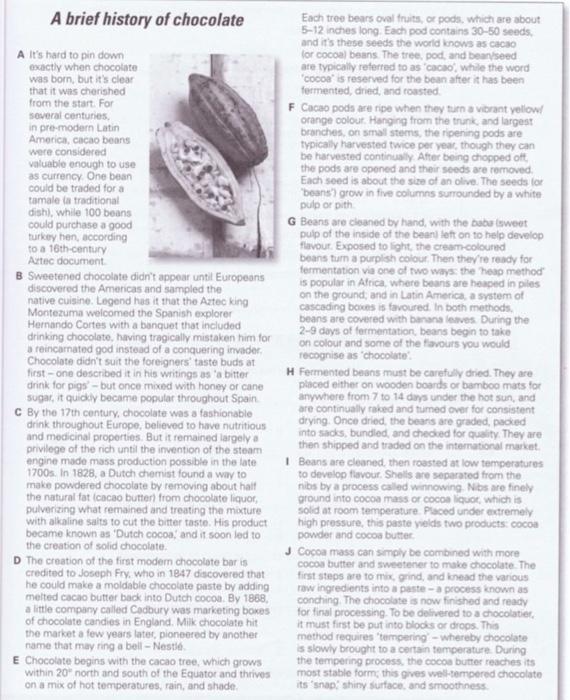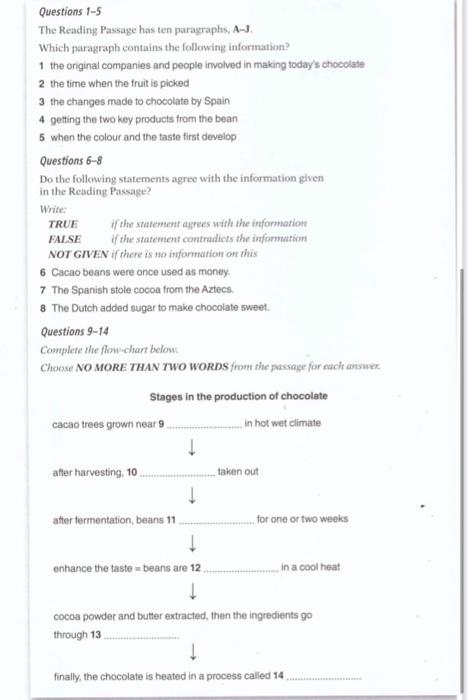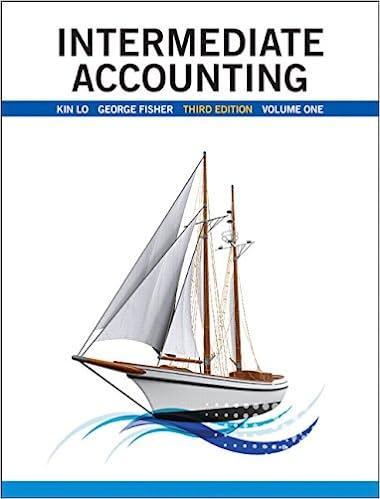Answered step by step
Verified Expert Solution
Question
1 Approved Answer
A brief history of chocolate A It's hard to pin down exactly when chocolate was born, but it's clear that it was cherished from


A brief history of chocolate A It's hard to pin down exactly when chocolate was born, but it's clear that it was cherished from the start. For several centuries, in pre-modern Latin America, cacao beans were considered valuable enough to use as currency. One bean could be traded for a tamale (a traditional dish), while 100 beans could purchase a good turkey hen, according to a 16th-century Aztec document. B Sweetened chocolate didn't appear until Europeans discovered the Americas and sampled the native cuisine. Legend has it that the Aztec king Montezuma welcomed the Spanish explorer Hernando Cortes with a banquet that included drinking chocolate, having tragically mistaken him for a reincarnated god instead of a conquering invader Chocolate didn't suit the foreigners' taste buds at first-one described it in his writings as 'a bitter drink for pigs-but once mixed with honey or cane sugar, it quickly became popular throughout Spain. C By the 17th century, chocolate was a fashionable drink throughout Europe, believed to have nutritious and medicinal properties. But it remained largely a privilege of the rich until the invention of the steam engine made mass production possible in the late 1700s. In 1828, a Dutch chemist found a way to make powdered chocolate by removing about half the natural fat (cacao butter) from chocolate liquor, pulverizing what remained and treating the mixture with alkaline salts to cut the bitter taste. His product became known as 'Dutch cocoa, and it soon led to the creation of solid chocolate. D The creation of the first modern chocolate bar is credited to Joseph Fry, who in 1847 discovered that he could make a moldable chocolate paste by adding melted cacao butter back into Dutch cocoa. By 1868, a little company called Cadbury was marketing boxes of chocolate candies in England. Milk chocolate hit the market a few years later, pioneered by another name that may ring a bell-Nestl. E Chocolate begins with the cacao tree, which grows within 20" north and south of the Equator and thrives on a mix of hot temperatures, rain, and shade. Each tree bears oval fruits, or pods, which are about 5-12 inches long. Each pod contains 30-50 seeds, and it's these seeds the world knows as cacao (or cocoal beans. The tree, pod, and bean/seed are typically referred to as "cacao, while the word 'cocoa' is reserved for the bean after it has been fermented, dried, and roasted F Cacao pods are ripe when they turn a vibrant yellow/ orange colour. Hanging from the trunk, and largest branches, on small stems, the ripening pods are typically harvested twice per year, though they can be harvested continually. After being chopped off, the pods are opened and their seeds are removed. Each seed is about the size of an olive. The seeds for "beans') grow in five columns surrounded by a white pulp or pith G Beans are cleaned by hand, with the baba (sweet pulp of the inside of the bean) left on to help develop flavour. Exposed to light, the cream-coloured beans turn a purplish colour. Then they're ready for fermentation via one of two ways: the heap method is popular in Africa, where beans are heaped in piles on the ground, and in Latin America, a system of cascading boxes is favoured. In both methods, beans are covered with banana leaves. During the 2-9 days of fermentation, beans begin to take on colour and some of the flavours you would recognise as "chocolate. H Fermented beans must be carefully dried. They are placed either on wooden boards or bamboo mats for anywhere from 7 to 14 days under the hot sun, and are continually raked and tumed over for consistent drying. Once dried, the beans are graded, packed into sacks, bundled, and checked for quality. They are then shipped and traded on the international market. I Beans are cleaned, then roasted at low temperatures to develop flavour. Shells are separated from the nibs by a process called winnowing Nibs are finely ground into cocoa mass or cocoa liquor, which is solid at room temperature. Placed under extremely high pressure, this paste yields two products: cocoa powder and cocoa butter. J Cocoa mass can simply be combined with more cocoa butter and sweetener to make chocolate. The first steps are to mix, grind, and knead the various raw ingredients into a paste-a process known as conching. The chocolate is now finished and ready for final processing. To be delivered to a chocolatier, it must first be put into blocks or drops. This method requires 'tempering-whereby chocolate is slowly brought to a certain temperature. During the tempering process, the cocoa butter reaches its most stable form; this gives well-tempered chocolate its 'snap; shiny surface, and smoothness. Questions 1-5 The Reading Passage has ten paragraphs, A-J. Which paragraph contains the following information? 1 the original companies and people involved in making today's chocolate 2 the time when the fruit is picked 3 the changes made to chocolate by Spain 4 getting the two key products from the bean 5 when the colour and the taste first develop Questions 6-8 Do the following statements agree with the information given in the Reading Passage? Write: TRUE if the statement agrees with the information if the statement contradicts the information NOT GIVEN if there is no information on this FALSE 6 Cacao beans were once used as money. 7 The Spanish stole cocoa from the Aztecs. 8 The Dutch added sugar to make chocolate sweet. Questions 9-14 Complete the flow-chart below. Choose NO MORE THAN TWO WORDS from the passage for each answer Stages in the production of chocolate in hot wet climate cacao trees grown near 9 after harvesting, 10. after fermentation, beans 11. enhance the taste-beans are 12. taken out for one or two weeks in a cool heat cocoa powder and butter extracted, then the ingredients go through 13.... finally, the chocolate is heated in a process called 14
Step by Step Solution
★★★★★
3.51 Rating (171 Votes )
There are 3 Steps involved in it
Step: 1

Get Instant Access to Expert-Tailored Solutions
See step-by-step solutions with expert insights and AI powered tools for academic success
Step: 2

Step: 3

Ace Your Homework with AI
Get the answers you need in no time with our AI-driven, step-by-step assistance
Get Started


